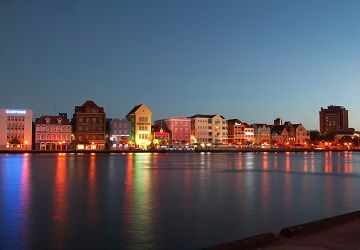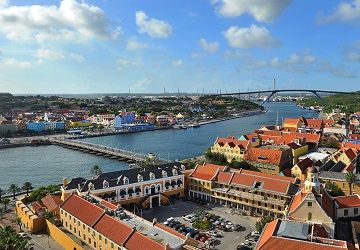Visit this Caribbean Gem for the Best of Beaches and Culture
Curaçao boasts beautiful beaches as well as a culture that is rich in cuisine and history.

Handelskade at night. Image Source: Curaçao Tourism
Curaçao lures vacationers with inviting beaches plus museums and cultural attractions. A shipping and refining center, Curaçao, some 35 miles off the coast of Venezuela, is home to more than 40 nationalities, creating an interesting mix of flavorful restaurants that reflect the islanders’ native cuisines.
Beaches
Curaçao has good beaches, but unlike on most Caribbean islands, the best sands don’t front the hotels. The prettiest coves lie along the northwestern coast. Our favorite beaches are palm-tree lined Kas Abou, Playa Knip, winner of a 2016 TripAdvisor Travelers’ Choice Award, and Klein Curaçao, an uninhabited island 8 miles off the coast. Although sometimes crowded, Playa Knip features an enticing cove and calm waters.

Willemstad. Image Source: Curaçao Tourism
Sites and Museums
Schottegat Harbor: Curaçao's natural harbor, Schottegat, as well as the historic areas of Punda were designated a UNESCO World Heritage site in 1997. The row of stately pastel-gabled buildings, is, arguably, the prettiest harbor in the Caribbean and a striking legacy of the island's centuries-old Dutch heritage.
In Willemstad, each morning on the Punda side of the canal, the schooners from Venezuela and Colombia tie up, their hammocks flapping in the breeze along the water. On the street side, merchants carefully arrange stacks of papayas, sweet potatoes, red peppers, and baby mangos. Others lay out rows of fish, shouting their names in Spanish — dorado, piscadara, purunche – to interested buyers. Watermelons, cut open to reveal their pink pulp, edge the front of some stalls like a rock border.
Museum Kura Hulanda: The museum showcases one of the largest African collections in the Caribbean. For me, the museum’s highlight is its exhibit on the African slave trade. By 1788, when the last slave galleon docked in Curaçao’s harbor, the West India Company had transported 500,000 Africans into slavery. Artifacts illustrating the brutality of the system include the traps used to capture people, the cages used to hold them, and the replica of a slave ship hold that mashed 400 children into a space that 50 would find crowded. Tours are available.
Restaurants: Located in up-and-coming Pietermaai, Kome, named for the Papiamentu word for “eat,” offers such island-inspired fare as curry, homemade sausage, fresh seafood and smoked beef brisket. Enjoy harbor views at Restaurant & Café Gouverneur De Rouville, known for such local dishes as keshi yena (filled cheeses), and pishka freshku (fresh fish) as well as for Caribbean chicken and Cuban banana soup.

Baoase. Image Source: Curaçao Tourism
Accommodations
Baoase: Situated on Curaçao’s southside, Baoase has a beach fronting a cove and features 23 rooms, suites and villas.
Sonesta Kura Hulanda Village & Spa, GHL Hotel: Near the center of Willemstad, the 82-room boutique hotel with hand-carved furnishings is located within Kura Hulanda Village.
Kura Hulanda Lodge & Beach Club, GHL: Located in Westpunt, this resort sits atop coral cliffs and has a beach.
ACTIVA BioACTIVE Bulk Flow Marks Pulpdent’s First Major Product Release in 4 Years
December 12th 2024Next-generation bulk-fill dental restorative raises the standard of care for bulk-fill procedures by providing natural remineralization support, while also overcoming current bulk-fill limitations.